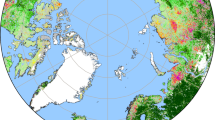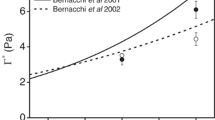Abstract
The International Panel on Climate Change (IPCC) predicted, from current trends in emissions and uptake, that the atmospheric CO2 concentration (Ca) would rise from its 1990 level of 354 μmol mol-1 to ca. 530 μml-1 mol-1 by 2050 and to over 700 μmol mol-1 by the end of the next century; i.e. a doubling of the present concentrations (Watson et al., 1990). This increase in the concentration of CO2 and other heteroatomic gas molecules in the troposphere is expected to lead to an increase in mean global temperatures of ca. 3°C by 2050 and ca. 4°C by 2100 (Watson et al., 1990). Tropospheric O3 concentrations in western Europe are expected to rise in parallel with CO2 concentrations from ca. 50 nmol mol-1 in 1990 at ca. 0.5% p.a. (Dizengremel, 1992) and are likely to depress concentrations of RubisCO in leaves which develop in these atmospheres (Pell, 1992). Rising tropospheric CO2 and O3 concentrations will modify the response of photosynthesis to a wide range of environmental variables, in particular temperature (Long, 1991). Any consideration of the effects of rising CO2 concentrations on photosynthetic production must therefore incorporate the interactive effects of rising temperature and rising tropospheric O3 concentration (Farage et al., 1991; Long, 1991; Long & Hutchin, 1991)
Access this chapter
Tax calculation will be finalised at checkout
Purchases are for personal use only
Preview
Unable to display preview. Download preview PDF.
Similar content being viewed by others
References
Ågren, G.I., McMurtrie, R.E., Parton, W.J., Pastor, J. & Shugart, H.H. (1991) State-of-the-art of models of production-decomposition linkages in conifer and grassland ecosystems. Ecological Applications, 1, 118–138.
Allen, L.H. Jr. (1990) Plant responses to rising carbon dioxide and potential interactions with air pollutants. Journal of Environmental Quality, 19, 15–34.
Berry, J.A. & Björkman, O. (1980) Photosynthetic response and adaptation to temperature in higher plants. Annual Reviews of Plant Physiology, 31, 491–543.
Campbell, W.J., Allen, L.H. & Bowes, G. (1988) Effects of CO2 concentration on RubisCO activity, amount, and photosynthesis in soybean leaves. Plant Physiology, 88, 1310–1316.
Delucia, E.H., Sasek, T.W. & Strain, B.R. (1985) Photosynthetic inhibition after long-term exposure to elevated levels of atmospheric carbon dioxide. Photosynthesis Research, 7, 175–184.
Dizengremel, P. (1992) This volume.
Eamus, D. (1991) The interaction of rising CO2 and temperatures with water use efficiency. Plant Cell and Environment, 14, 843–852.
Ehleringer, J.R. & Björkman, O (1977) Quantum yields for CO2 uptake in C3 and C4 plants. Plant Physiology, 59, 86–90.
Esser, G. (1987) Sensitivity of global carbon pools and fluxes to human and potential climatic impacts. Tellus 39B, 245–260.
Esser, G. (1991) Geographically referenced models of net primary productivity and litter decay. Ecological Applications (in press).
Evans, J.H. & Farquhar, G.D. (1992) Modeling canopy photosynthesis from the biochemistry of the C3 chloroplast. In Modeling Crop Photosynthesis — from Biochemistry to Canopy, ed. K.J. Boote & R.S. Loomis. Crop Science Society of America, Madison, pp. 1–15.
Farage, P.K., Long, S.P., Lechner, E.G. & Baker, N.R. (1991) The sequence of change within the photosynthetic apparatus of wheat following short-term exposure to ozone. Plant Physiology 95, 529–535.
Farquhar, G.D., von Caemmerer, S. & Berry, J.A. (1980) A biochemical model of photosynthetic CO2 assimilation in leaves of C3 species. Planta, 149, 78–90.
Farquhar, G.D. & von Caemmerer, S. (1982) Modeling of photosynthetic responses to environmental conditions. In Physiological Plant Ecology II. Encyclopedia of Plant Physiology New Series Vol. 12B, ed. O.L. Lange, P.S. Nobel, C.B. Osmond & H. Ziegler, Springer, Berlin, pp. 548–577.
Harley, P.C. & Tenhunen, J.D. (1992) Modeling the photosynthetic response of C3 leaves to environmental factors. In Modeling Crop Photosynthesis — from Biochemistry to Canopy, ed. K.J. Boote & R.S. Loomis. Crop Science Society of America, Madison, pp. 17–39.
Idso, S.B. (1989) Carbon Dioxide and Global Change: Earth in Transition. DBR Press, Tempe, Arizona.
Jordan, D.B. & Ogren, W.L. (1984) The CO2/O2 specificity of ribulose 1,5-bisphosphate concentration, pH and temperature. Planta, 161, 308–313.
Long, S.P. (1991) Modification of the response of photosynthetic productivity to rising temperature by atmospheric CO2 concentrations. Has its importance been underestimated? — Opinion. Plant Cell and Environment 14, 729–739.
Long, S.P. & Drake, B.G. (1991) Effects of the long-term elevation of CO2 concentration in the field on the quantum yield of photosynthesis of the C3 sedge, Scirpus olneyi. Plant Physiology 96, 221–226.
Long, S.P. & Drake, B.G. (1992) Photosynthetic CO2 assimilation and rising atmospheric CO2 concentrations. In: Crop photosynthesis and the Environment ed. N.R. Baker & H. Thomas, Elsevier, Amsterdam, (in press).
Long, S.P. & Hutchin, P. (1991) Primary production in grasslands and coniferous forests in relation to climate change and rising CO2 levels. Ecological Applications, 1, 139–156.
McMurtrie, R.E. & Wang, Y.-P. (1992) Mathematical models of the photosynthetic response of plant stands to rising CO2 levels and temperatures. Plant Cell and Environment, 15, (in press).
Melillo, J.M., Callaghan, T.V., Woodward, F.I., Salati, E. & Sinha, S.K. (1990) Effects on ecosystems. In Climate Change. The IPCC Scientific Assessment ed. J.T. Houghton, G.J. Jenkins & J.J. Ephraums, Cambridge University Press, Cambridge, pp. 283–310
Mott, K.A. (1990) Sensing of atmospheric CO2 by plants. Plant Cell and Environment, 13, 731–737.
Parry, M.L. & Carter, T.R. (1988) The assessment of effects of climatic variations on agriculture: aims, methods and summary of results. In The Impact of Climatic Variation on Agriculture Vol. 1 ed. M.L. Parry, T.R. Carter & N.T. Konijn, Kluwer, Dordrecht, pp. 11–95.
Parry, M.L. & Carter, T.R. (1990) An assessment of the effects of climatic change on agriculture. In Climatic Change and Plant Genetic Resources ed. M. Jackson, B.V. Ford-Lloyd & M.L. Parry, Belhaven, London, pp. 61–84.
Pell, E. (1992) This volume
Sage, R.F., Sharkey, T.D. & Seemann, J.R. (1989) Acclimation of photosynthesis to elevated CO2 in five C3 species. Plant Physiology, 89, 590–596.
Schimmel, D. (1990) Biogeochemical feedbacks in the Earth system. In Global Warming. The Greenpeace Report (ed. J. Leggett), pp. 68–82, Oxford University Press, Oxford.
Sharkey, T.D. & Socias, X. (1992) This volume.
Stitt, M. (1991) Rising CO2 levels and their potential significance for carbon flow in photosynthetic cells. Plant Cell and Environment, 14, 741–762.
Terashima, I., Wong, S.-C., Osmond, C.B. & Farquhar, G.D. (1988) Characterization of non-uniform photosynthesis induced by abscissic acid in leaves having different mesophyll anatomies. Plant Cell Physiology, 29, 385–394.
Watson, R.T., Rodhe, H., Oescheger, H. & Siegenthaler, U. (1990) Greenhouse gases and aerosols. In Climate Change. The IPCC Scientific Assessment eds. J.T. Houghton, G.J. Jenkins & J.J. Ephraums, Cambridge University Press, Cambridge, pp. 1–40.
Wong, S.C. (1979) Elevated atmospheric partial pressure of CO2 and plant growth. I. Interactions of nitrogen nutrition and photosynthetic capacity in C3 and C4 plants. Oecologia, 44, 68–74.
Editor information
Editors and Affiliations
Rights and permissions
Copyright information
© 1994 Springer Science+Business Media Dordrecht
About this chapter
Cite this chapter
Long, S.P. (1994). The potential effects of concurrent increases in temperature, CO2 and O3 on net photosynthesis, as mediated by RubisCO. In: Alscher, R.G., Wellburn, A.R. (eds) Plant Responses to the Gaseous Environment. Springer, Dordrecht. https://doi.org/10.1007/978-94-011-1294-9_2
Download citation
DOI: https://doi.org/10.1007/978-94-011-1294-9_2
Publisher Name: Springer, Dordrecht
Print ISBN: 978-94-010-4565-0
Online ISBN: 978-94-011-1294-9
eBook Packages: Springer Book Archive




